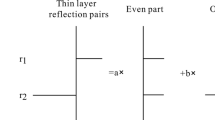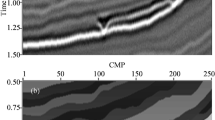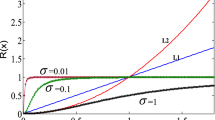Abstract
The prior information constrained impedance inversion is an important tool to improve the inversion effect. With the traditional constrained prior information extracted from logging data by the analytic formula, it is difficult to accurately describe the information of a complex reservoir. In addition, the traditional inversion method is trace-by-trace, which ignores the lateral information contained in seismic data. This paper presents a multichannel seismic impedance inversion method combining logging and seismic. In this method, the dictionary learning method is used to extract the vertical prior information of the formation from the logging data. At the same time, we can learn the dip information from seismic data cube. Under the framework of multichannel inversion, regularization and sparse representation technology are used to simultaneously add the vertical and the transverse distribution prior information into the inversion process. Block coordinate descent method is used to solve the multichannel inversion problem, making the seismic inversion efficient. This method excavates the spatial prior information in a data-driven way and is used for constrained inversion, avoiding the false prior cognition caused by manual interpretation. Through the model and field data testing, it is verified that this method is effective.










Similar content being viewed by others
References
Aharon M, Elad M, Bruckstein A (2006) K-SVD: An algorithm for designing overcomplete dictionaries for sparse representation. IEEE Trans Signal Process 54(11):4311–4322
Asnaashari A, Brossier R, Garambois S, Audebert F, Thore P, Virieux J (2013) Regularized seismic full waveform inversion with prior model information. Geophysics 78(2):R25–R36
Fomel S (2002) Applications of plane-wave destruction filters. Geophysics 67(6):1946–1960
Fridman V (1965) A method of successive approximations for Fredholm integral equations of the first kind. Uspeki Mat Nauk 11:233–234
Gotsman C, Surazhsky V (2001) Guaranteed intersection-free polygon morphing. Comput Graph 25(1):67–75. https://doi.org/10.1016/S0097-8493(00)00108-4
Hansen PC (1990) Truncated singular value decomposition solutions to discrete ill-posed problems with ill-determined numerical rank. SIAM J Sci Stat Comput 11(3):503–518
Landweber L (1951) An iteration formula for Fredholm integral equations of the first kind. Am J Math 73(3):615–624
Ma M, Wang S, Yuan S, Wang J, Wen J (2017) Multichannel spatially correlated reflectivity inversion using block sparse Bayesian learning. Geophysics 82(4):V191–V199
Ma M, Wang S, Yuan S, Gao J, Li S (2018) Multichannel block sparse Bayesian learning reflectivity inversion with lp-norm criterion-based Q estimation. J Appl Geophys 159:434–445
Ma M, Zhang R, Yuan S (2019) Multichannel impedance inversion for nonstationary seismic data based on the modified alternating direction method of multipliers. Geophysics 84(1):A1–A6
Robinson EA (1985) Seismic time-invariant convolutional model. Geophysics 50(12):2742–2751
Roy P, Zhu X, Fei W (2020) Machine learning assisted seismic inversion. SEG technical program expanded abstracts, pp 1705–1709
She B, Li K, Liu Z, Wang Y, Cai H, Liu W, Hu G (2018) Seismic impedance inversion using dictionary learning and sparse representation. SEG Technical Program Expanded Abstracts 2018:396–400
She B, Wang Y, Liu Z, Cai H, Liu W, Hu G (2019) Seismic impedance inversion using dictionary learning-based sparse representation and nonlocal similarity. Interpretation 7(3):SE51–SE67
Wang Y, Lin W, Cheng S, She B, Hu G, Liu W (2018) Sharp and laterally constrained multitrace impedance inversion based on blocky coordinate descent. Acta Geophys 66(4):623–631
Wang Y, Liu Y, She B, Hu G, Jin S (2021) Data-driven pre-stack AVO inversion method based on fast orthogonal dictionary. J Pet Sci Eng 201:108362
Yuan S, Wang S, Luo C, He Y (2015) Simultaneous multitrace impedance inversion with transform-domain sparsity promotion. Geophysics 80(2):R71–R80
Yuan S, Wang S, Tian N, Wang Z (2016) Stable inversion-based multitrace deabsorption method for spatial continuity preservation and weak signal compensation. Geophysics 81(3):V199–V212
Zhdanov MS (2002) Geophysical inverse theory and regularization problems, vol 36, Elsevier
Zhou D, Yin X, Zong Z (2019) Multi-trace basis-pursuit seismic inversion for resolution enhancement. Geophys Prospect 67(3):519–531
Author information
Authors and Affiliations
Corresponding author
Ethics declarations
Conflict of interest
The authors declare that they have no conflict of interest.
Additional information
Communicated by Prof. Sanyi Yuan (ASSOCIATE EDITOR) / Prof. Michał Malinowski (CO-EDITOR-IN-CHIEF).
Rights and permissions
About this article
Cite this article
Li, X., Wang, Y., Liu, Y. et al. Multichannel seismic impedance inversion driven by logging–seismic data. Acta Geophys. 69, 2261–2274 (2021). https://doi.org/10.1007/s11600-021-00687-2
Received:
Accepted:
Published:
Issue Date:
DOI: https://doi.org/10.1007/s11600-021-00687-2




